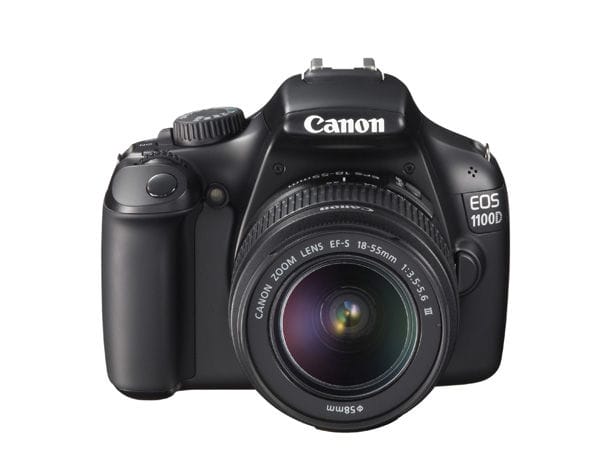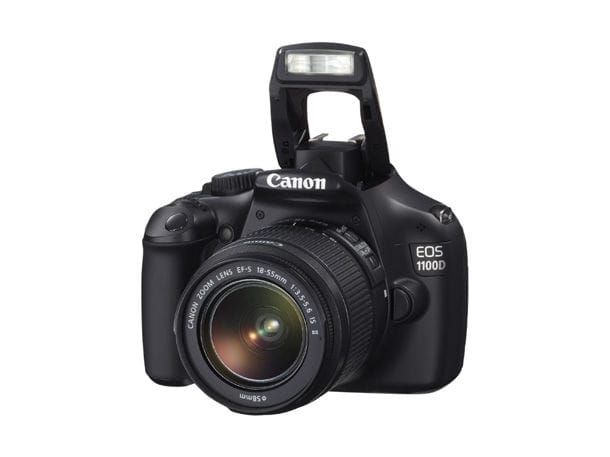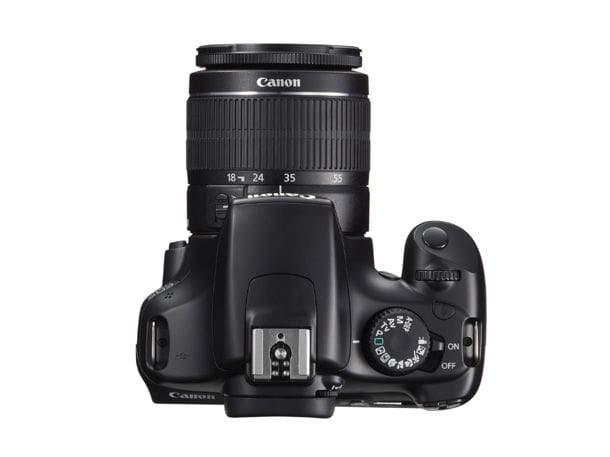As well as the new Canon 600D /T3i , Canon have also release the new Canon 1100D / T3 which sits a little lower in the product lineup but still features a ton of awesome features.
Main Features:
- 12.1MP
- Available in Black and Red
- 9-point AF system
- DIGIC 4 image processor
- 3fps
- 2.7″ LCD (230,000-dot)
- HD video at 30p
Press Release
London, UK, 7th February 2011 – Canon today unveils the new EOS 1100D – the Digital SLR (DSLR) for consumers who want to take the first step on their journey to outstanding still images and HD video. Featuring many technologies developed for more advanced models, and functions which make it even easier to capture fantastic images straight out of the box, the EOS 1100D helps you to have fun with your photography and impress your friends with amazing portraits, landscapes or creative shots.
As your skills develop, the EOS 1100D grows with you. As the gateway to Canon’s world-famous EOS System, the EOS 1100D lets you experiment with more than 60 different lenses and other accessories including Speedlite flashes, to explore the world of photography.
Advanced imaging made easy
Compact and lightweight, the EOS 1100D is a highly versatile DSLR that’s easy to carry with you, allowing you to capture any moment in stunning quality. When a scene lends itself to video as well as stills, 720p HD video capture is easily accessible via the dedicated movie function on the mode dial. Never miss a moment of the action as you frame your image easily and accurately through the newly-designed, bright optical viewfinder, offering 95% coverage of the scene. Alternatively, use Live View to see how different shooting modes will affect the final image on the large rear screen.
You’ll be able to take great images as soon as you start using the EOS 1100D. A Feature Guide in the menu system offers a brief description of each key camera setting and its effect, helping beginners to learn about their camera as they use it.
Basic+ and Creative Auto remove any confusing technical terms, using plain language to describe settings and their effect on the final image. Apply a different ambience to a scene, with Basic+ adjusting exposure, white balance and image processing settings according to easy-to-understand pre-sets based on the creative intent or lighting type. Alternatively, blur the background to create more interesting results with Creative Auto, which takes all the confusion out of achieving the desired effect.
Shoot and share anywhere
The EOS 1100D also makes it easier to shoot and instantly share your images and HD video with friends and family. The large 6.8cm (2.7”) LCD screen features a sharp 230k-dot resolution and wide viewing angle, making it easy to review the day’s shoot immediately. Alternatively, sit back and enjoy the big-screen image playback by connecting the EOS 1100D directly to an HDTV via HDMI, using the TV remote control to scroll through images and enjoy your own high-quality video.
Thanks to support for Eye-Fi Connected Functions*1, EOS 1100D users can wirelessly transfer their images to a home PC or bypass this stage completely and upload images and video direct to an online sharing account like the CANON iMAGE GATEWAY or Flickr – inspiring everyone to share special, fun and creative photography.
From beginners to pros, the EOS system is used the world over
Designed as a user-friendly, powerful, entry-level DSLR, the EOS 1100D features an impressive specification to support the image quality and performance promised by the Canon and EOS brands.
A 12.2 Megapixel APS-C CMOS sensor enables A3 size images to be recorded or cropped for exciting compositions, without compromising on image quality or print size, while DIGIC 4 image processing allows you to freeze the action with high-speed shooting at 3 frames per second*2. Low light subjects can be captured with minimal noise and without resorting to using a flash thanks to a sensitive ISO range of 100 – 6400, and the fast, accurate nine-point autofocus (AF) system ensures the subject is in focus no matter where they may stand in the frame. The EOS 1100D also uses the same iFCL metering system developed for the semi-professional EOS 7D, ensuring all subjects are well-exposed, even in the most challenging lighting conditions.
The EOS 1100D will be available with a new addition to Canon’s range of EF lenses. The EF-S 18-55mm f/3.5-5.6 IS II is a new kit lens that offers EOS 1100D users the flexibility to shoot everything from sweeping landscapes to portraits. A lightweight construction means it’s easy to carry, and Canon’s acclaimed optical Image Stabilization offers a 4-stop advantage to ensure sharp images at maximum zoom and when shooting in low light. The new EF-S 18-55mm f/3.5-5.6 IS II will succeed the EF-S 18-55mm f/3.5-5.6 IS in Canon’s current lens portfolio.
EOS 1100D – key features:
- Superior 12-megapixel image quality
- On-screen Feature Guide
- Creative Auto and Basic+
- HD video capture
- ISO 100-6400 sensitivity
- Wide-area 9-point AF system
- 63-zone iFCL exposure metering
- 6.8cm (2.7”), 230,000-dot screen
- Use with all EF and EF-S lenses
*1 This product is not guaranteed to support Eye-Fi card functions (including wireless transfer). In case of an issue with an Eye-Fi card, please check with the card manufacturer. Also note that approval is required to use Eye-Fi cards in many countries or regions. Without approval, use of the card is not permitted. If it is unclear whether the card has been approved for use in the area, please check with the card manufacturer
*2 JPEG file size only
Technologies explained
Canon CMOS sensor
Exclusively designed and manufactured by Canon to work in combination with its own DIGIC processors, Canon’s CMOS technology integrates advanced noise reduction circuitry at each pixel site, delivering virtually noise-free images. In comparison with CCD technology, the lower power consumption characteristics of Canon’s CMOS sensors also contribute to longer battery life.
Signal conversion in Canon’s CMOS sensors is handled by individual amplifiers at each pixel site. Unnecessary charge transfer operations are avoided, vastly speeding up the process of getting the signal to the image processor. Noise is reduced, power consumption is limited and faster frame rate potential is increased.
DIGIC 4
Image data captured by the CMOS sensor is processed by Canon’s purpose-built
DIGIC 4 image processors before being written to memory card. DIGIC technology uses advanced image processing algorithms to ensure precise, natural colours, tonal gradation, accurate white balance, and advanced noise reduction. Ultra-fast processing speeds result in highly responsive camera operation and near-instant start-up times.
DIGIC chips work with a high speed image buffer, reading, processing, compressing and writing image data fast enough to keep the buffer clear during long continuous shooting bursts. In addition, because DIGIC 4 integrates all key processing functions, power consumption is kept to a minimum.
iFCL metering system with 63-zone Dual-layer Metering sensor
The iFCL system uses focus, colour and luminance information to determine consistently exposed shots. All focus points provide distance information to the metering system to determine the location of the subject and allow the algorithm to weight the exposure accordingly.
Both the EOS 600D and EOS 1100D models feature a metering sensor with 63 zones, compatible with all nine AF points. Typically, metering sensors are more sensitive to red subjects which can lead to overexposure. The EOS 600D and EOS 1100D counter this with the dual layer sensor, which has one layer sensitive to red and green light and one that is sensitive to blue and green light. The metering algorithm then compares the level of the two layers and adjusts the meter reading accordingly.
EOS Integrated Cleaning System
The new EOS 600D features the EOS Integrated Cleaning System, used to combat sensor dust in three important ways: Reduce, Repel and Remove.
- Reduce – Internal camera mechanisms are designed to minimise dust generation. The redesigned body cap prevents dust generation through wear on the cap itself
- Repel – Anti-static technologies, including a magnesium fluoride coating, are applied to the low-pass filter covering the front of the sensor so as not to attract dust
- Remove – A Self-Cleaning Sensor Unit uses hi-frequency vibrations to shake dust from the infrared filter for a period of approximately one second after each start up. For instant shooting after power up, this feature is disabled immediately as the shutter release is depressed
The front surface of the EOS 1100D’s low-pass filter features a fluorine coating to minimize dust adhesion to the sensor. Both the EOS 600D and the EOS 1100D feature an internal Dust Delete Data system, which can map the position of visible dust on the sensor. This can then be deleted automatically after the shoot with the latest Digital Photo Professional software.
EOS Movie
EOS Movie allows users to record Full HD (1920x1080p) movies on the EOS 600D and HD (1280x720p) movies on the EOS 1100D. The EOS 600D offers full manual control of exposure and frame rates of 30, 25 and 24 fps at full resolution, with 60 and 50 fps available at 720p resolution. The EOS 1100D has a choice of 30 and 25 fps frame rates.
When filming Full HD footage with the EOS 600D, Movie Digital Zoom can be used to magnify the centre of the sensor by 3-10x while maintaining Full HD quality.
Picture Styles
Picture Style presets can be likened to different film types – each one offering a different colour response. Within each selectable preset, photographers have control over sharpness, contrast, colour tone and saturation. The camera’s Standard Picture Style is designed to deliver immediately-usable JPEG images without need for additional processing. When shooting RAW images Picture Styles can be revised with Canon’s Digital Photo Professional software.
The presets available with both the EOS 600D and EOS 1100D are:
- Standard: For crisp, vivid images that don’t require post-processing.
- Portrait: Optimises colour tone and saturation and weakens sharpening to achieve attractive skin tones.
- Landscape: For punchier greens and blues with stronger sharpening to give a crisp edge to mountain, tree and building outlines.
- Neutral: Ideal for post-processing.
- Faithful: Adjusts colour to match the subject colour when shot under a colour temperature of 5200K.
- Monochrome: For black and white shooting with a range of filter effects (yellow, orange, red and green) and toning effects (sepia, blue, purple and green.
A new Picture Style has been added to the EOS 600D – Picture Style Auto. This new Picture Style makes fine adjustments, based on the EOS Scene Detection System’s analysis, to create a Picture Style for the particular image. Three User Defined Picture Styles can be used to store customised pre-sets created using the supplied Picture Style Editor, or any of the pre-sets available for download from Canon’s web site: www.canon.co.jp/Imaging/picturestyle/file/index.htm
Basic+
Basic+ is a creative imaging function that was first introduced in the EOS 60D, which makes it easier to create the desired image effects when shooting a scene. With Basic+, photographers have the option to apply a creative intent to their images whilst using the scene-based modes.
- Shoot by ambience: exposure compensation and white balance are adjusted according to preset styles to create ambience or tone in the image
- Shoot by lighting or scene type: a simplified form of white balance, which allows new digital photographers to change the white balance settings according to more understandable terms such as “Daylight”, “Shade”, “Cloudy”, “Sunset”, “Tungsten light” and “Fluorescent light”
Auto Lighting Optimizer (ALO)
Auto Lighting Optimiser analyses the image and selectively adjusts the brightness to achieve a more even result. For example, when a person is backlit, ALO detects the face and increases its brightness to ensure a more pleasing image.
Lens peripheral illumination correction
The lens peripheral illumination correction function uses the power of the DIGIC 4 image processor to improve image quality by maintaining evenness of illumination from corner to corner, even when shooting wide open with a zoom lens. When shooting in RAW this correction can be further adjusted using
Digital Photo Professional.
Highlight Tone Priority
With Highlight Tone Priority the dynamic range of the highlight tones is extended. The gradation between 18% greys (standard exposure) and the highlights are improved, reducing loss of detail in highlights. This enables a picture with a large proportion of highlights, such as a brightly-lit bride in her wedding gown, to show greater detail in the white and grey areas of the photo, making the image more attractive and natural.
Feature Guide
The Feature Guide acts as an on-board guide by displaying a simple description of each mode and the functions on the Quick Control Screen.
Digital Photo Professional Software
Digital Photo Professional (DPP) software provides high speed, high quality processing of lossless RAW images. Processing with Digital Photo Professional allows real-time display and immediate application of image adjustments, giving control over RAW image variables such as white balance, dynamic range, exposure compensation, noise reduction and colour tone – plus the ability to view Auto Focus points on an image and apply un-sharp mask sharpening. The Lens Aberration correction tool allows precise correction of different types of distortion caused by certain lenses. Newly added is a set of distortion corrections for use with the EF 8-15mm f/4L USM Fisheye. These corrections allow you to produce fisheye images for different uses.
- Emphasize Linearity: Converts the image to a ‘Central Projection’ style image. This creates a full frame image from a circular fisheye image.
- Emphasize Distance: This converts the image into an ‘Equidistant Projection’ image. This method preserves distance relationships between objects, but removes much of the distortion. It is particularly useful for creating star maps and solar path diagrams.
- Emphasize Periphery: This converts the image into a ‘Stereographic Projection’ image. This allows positional relationships on a spherical surface to be displayed correctly, such as an image of a globe.
- Emphasize Centre: This converts the image to an ‘Orthogonal Projection’ image, enlarging the centre of the image. This is useful for city planners to measure the luminance of an area by the sky to ensure adequate lighting.
Images can be recorded in camera with sRGB or Adobe RGB colour space. Images can also be rotated and trimmed allowing photographers to correct framing and horizons as part of the RAW processing. Digital Photo Professional also provides full support for the rating system within the EOS 600D and EOS 1100D allowing star ratings to be added or edited for easier sorting.
Digital Photo Professional supports sRGB, Adobe RGB, ColorMatch RGB, Apple RGB and
Wide Gamut RGB colour spaces. ICC (International Colour Consortium) profiles can be attached to TIFF or JPEG images when converted from RAW. This allows faithful reproduction of colours in software applications that support ICC profiles, such as Adobe Photoshop. For improved efficiency, a set of image adjustments can be saved as a recipe and applied.
EOS Utility
The latest version of EOS Utility provides essential support for Live View remote shooting (with the ability to overlay an image to assist with alignment of subsequent shots during product photography), camera configuration and image transfers. Tightly integrated with Digital Photo Professional, EOS Utility can be configured to monitor ‘hot’ folders, automatically renaming and moving incoming images to a structured file system. Images can also be tagged with EXIF data, including copyright information. Newly added is the ability to register background music, with users now able to add or remove .WAV format files from the playlist used by the camera*3.
Picture Style Editor
Picture Style Editor allows photographers to create individual Picture Styles that meet their personal requirements. Each Picture Style contains detailed information on how specific colours should be represented within an image. Once new Picture Styles have been created, they can be uploaded directly into the camera and applied to JPEG or RAW images. When working with RAW files in DPP, both personal Picture Styles and predetermined Picture Styles can be adjusted.
ZoomBrowser EX (PC)/ImageBrowser (MAC)
ZoomBrowser EX/ImageBrowser is designed to give photographers a quick and easy way of managing their images. Basic JPEG editing functionality enables users to adjust image brightness and colour balance, with an in-software connection to DPP for RAW image editing. Users can select, rename and resize multiple images at once, set star ratings and organise images by shooting date, making it simple to manage large image libraries. Photographers can also select, add comments and then print images via a range of simplified printing options, and direct uploads to
CANON iMAGE GATEWAY enables image sharing via personal online photo albums.
ZoomBrowser EX/ImageBrowser also offers support for video editing, including a new Video Snapshot Edit Task that makes it easy for users to manage, edit and share Video Snapshot Albums.
Video Snapshot Edit Task
This feature allows Video Snapshot Albums to be edited using a computer. Individual snapshots can be removed or reordered, and a background music track can also be added*3. The resulting file can be uploaded to YouTube™ quickly and easily using a new YouTube™ upload task.
*3 Copyright laws in your country may prohibit the use of your recorded images or copyrighted music and images with music in the memory card for anything but private enjoyment.






